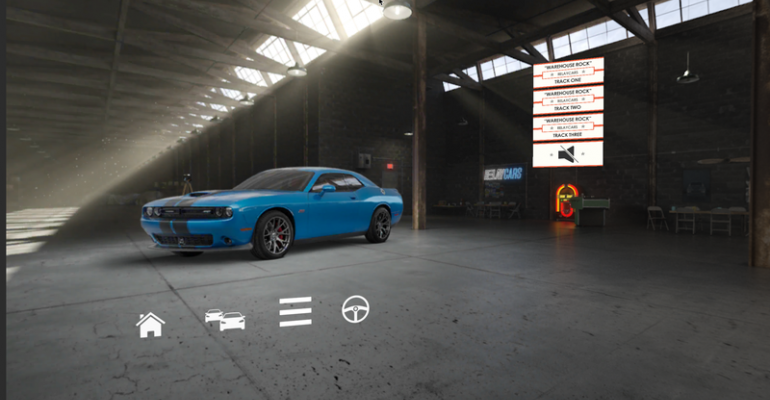Evox Images executives Dave Weber and Pat Hadnagy don’t necessarily view the world through rose-colored glasses. They prefer the likes of a Gear VR headset attached to a Samsung Galaxy smartphone. They’re optimistic about what they see there on a couple of accounts.
First, the headgear is a means for wearers to check out thousands of 360-degree views of vehicles in Evox’s growing photo library. Viewers can check out cars at all sorts of angles and in different locations, such as a beach or a storage garage.
Second, Weber, who is Evox’s vice president-sales and marketing, and Hadnagy, the company’s vice president-virtual reality, see this type of virtual reality as ready to blast off.
There are about a million VR headsets in use in the U.S., mostly by gamers. Evox is convinced the technology is poised to explode into the mainstream as an effective and a fun way to shop online, particularly for cars.
Virtual Reality is a computer-generated simulation of a multiple-dimensional image or environment that people can interact with in a seemingly real way.
A Pew study indicates 150 million VR sets in various versions – including $5 Google Cardboard VR goggles – will be in use by 2020.
“Our company is drinking the Kool-Aid,” Weber tells WardsAuto. With Evox as the licensing firm for the expanding photo library, he foresees automakers and dealers promoting the technology both to make and sell cars.
“We believe we are getting close to the tipping point in that the mass production of headsets is months away, not years,” he says. “This will be how consumers shop.”
Weber speaks not just of people using VR to shop for vehicles but also other things such as houses and vacation resorts.
“But automotive remains our focus,” Hadnagy says. “We’ve been good at it.”
Vehicle shoppers can “literally get behind the wheel of a car, and from a marketing standpoint, that is, butts in seats,” Weber says, referring to an auto-retailing axiom that getting shoppers inside a car enhances the chances of them buying it.
“We believe people will be at home checking cars out this way before they go into a dealership,” he adds.
Evox’s 360-degree images already are used by about 22,000 dealer websites.
Weber speaks of the prospects of dealers creating a virtual showroom both to enhance the customer shopping experience and to reduce the need for maintaining high levels of actual inventory.
But not all dealers are convinced yet of the wonders of VR, particularly if a featured vehicle is not on the lot. Weber recalls one dealership sales manager saying, “If we don’t have this, sell something we do have.”
For automakers, Evox’s resources could help in vehicle product development. Teams at various geographical locations could get up close and personal views of vehicles in development, rather than transport the actual model from place to place, Weber says.
An automaker in development can have a protected site with their products added to a competitive set to compare, say, headlights or wheels in a crowded showroom.
In addition to offering its auto stock photography, 360-degree imaging and global build-to-order automotive content, Evox recently introduced a mobile app, RelayCars.
The firm is talking to U.S. and European automakers about setting up licensing deals to use their images in various ways, from clinics to sales and marketing.
An automaker can license a customized version of a VR showroom that has details on products and popups showing the nearest dealer.
Using virtual reality in a consumer clinic allows the automaker to gauge reaction to the product using biometric feedback to measure what catches the eye and evaluate the emotional response.
That generates hard data on all-important first reactions, Hadnagy tells WardsAuto.
“It records quick emotional responses. Someone could rate a car high. We can see if that corresponds to their emotional response or if they are just being polite. It also records what specifically they are looking at.”
VR is expected to really resonate with young car buyers, Weber says. “Millennials are looking for entertainment.”
Based in Rancho Dominguez, CA, Evox has five studios and robotic camera setups where each vehicle undergoes about 60 standardized 2-D and 3-D shots so all show the same angles and features, Hadnagy says.
The licensing company can shoot and process images of up to 25 cars a week and add about 650 new vehicles to the library each year.





